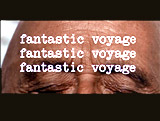
|
Fantastic Voyage (1966)
In Richard Fleischer's and 20th Century Fox's classic
science-fiction adventure film (the most expensive of its time) and
Cold War thriller - it was
one of the most influential sci-fi films of the 1960s, until Stanley
Kubrick's 2001:
A Space Odyssey (1968). Its tagline described its premise:
"A Fantastic and Spectacular Voyage...Through the Human Body...Into the
Brain."
Much of the CinemaScopic film's
$5.1 million budget was spent on post-production special effects,
animation and the sets. Director Fleischer's previous and similar
sci-fi film was another 'voyage'-type film: 20,000
Leagues Under the Sea (1954), and he would later go on to direct Soylent
Green (1973). Scriptwriter Harry Kleiner's high-concept plot
contained original story elements from sci-fi writers Otto Klement
and Jerome Bixby, and was adapted by David Duncan.
The big-budget, escapist film's basic
'fantastic' premise was to miniaturize a team of humans to take a voyage
in a shrunken, nuclear-powered submarine (the USS Proteus, Model
U-91035) into inner space - into the body of a comatose patient.
(The full-size of the Proteus was 41 1/2 feet in length, 23 feet
wide, 15 feet high, and weighing 4 tons). There were four smaller
versions of the sub, ranging from one and one half inches to five feet
in length.The micro-pioneers' mission, seen as an adventurous travelogue,
was to journey through the body via an artery to the man's brain and
relieve a life-threatening blood clot with an experimental laser beam
- within 60 minutes. They would run into oxygen supply problems, turbulent
environments in the lava lamp-like currents of blood vessels, and white-blood
cell attacks, plus suspicions of a saboteur and a one-hour ticking
clock before miniaturization reversed itself.
In addition to the special effects, various sets
and blue-screens, different-sized models and miniatures were used
to depict the submarine in the film, and the interior of the scientist's
body. The life-like, imaginative reproductions and visualizations
of internal human organs, the human anatomy and physiology, and various
other components were based upon medical illustrations provided by
UCLA to the studio's art department.
As the "voyage' proceeded through
the patient's body and its alien worlds, there were highly-detailed
encounters with each of the main human organs or systems - the heart
(circulatory system), the lungs (respiratory system), the lymphatic
system (a protective system of fluids to protect against bacteria,
including white blood cells), and the brain, plus interactions with
the inner ear and several veins and arteries. Through
various techniques, the explorers were seen 'scuba-diving' (swimming)
through the body (the actors were suspended on wires).
The iconic film was followed with
a TV series also titled Fantastic Voyage, airing for only
one season from 1968-1969, and starring Marvin Miller, Ted Knight,
and Jane Webb. The film was very reminiscent
of Fox's and Irwin Allen's earlier smash hit Voyage to the
Bottom of the Sea (1961), that also was adapted into a TV-series spinoff from 1964-1968.
A novelization of the film's screenplay
was penned by Isaac Asimov and released a few months prior to the
film. It first appeared in a serialized, abridged form in The
Saturday Evening Post, and then as a popular hardcover book.
One variant of the film was director Joe Dante's comical Innerspace
(1987), starring Dennis Quaid and Meg Ryan. A few years
later in 1989 (lasting through 2007), Walt Disney World's (or Epcot's) Body
Wars, a 7-minute motion-simulator ride attraction, took guests
through the human body and presented
the same ideas of shrinking down and journeying through. A complete
rip-off of the 1966 film was director Christian McIntire's direct-to-video
action-horror film Antibody (2002) starring Lance Henriksen and Robin Givens.
From its five Academy Award nominations (including
Best Film Editing, Best Sound Effects, and Best Cinematography (for
Ernest Laszlo)), it won two Oscars: Best Special Visual Effects (for
its cutting-edge designs and special effects), and Best Art Direction-Set
Decoration. The scenes requiring the most special effects included
four set-pieces: the miniaturization and injection into the blood
stream, the emergency route through the heart, the attack of the
antibodies, and the final battle with white corpuscles.
- before the opening credits, a prologue subtitle
was presented: "This film will take you where no one has ever been
before; no eye witness has actually seen what you are about to
see. But in this world of ours where going to the moon will soon
be upon us and where the most incredible things are happening all
around us, somebody, perhaps tomorrow, the fantastic events you
are about to see can and will take place"
- in the opening sequence set in the year 1995, noted
Communist Czech scientist Dr. Jan Benes (Jean Del Val) who was
defecting from behind the Iron Curtain (with the CIA's assistance),
arrived on a TWA jet in Los Angeles on a night-flight; he was
accompanied by American government secret agent Charles Grant (Stephen
Boyd); shortly later during an assassination attempt, his motorcade
caravan of Secret Service agents and motorcycle cops was ambushed
when his car was rammed; after changing cars, he was then shot
at by snipers, causing severe and possibly fatal head injuries
to the scientist; Dr. Benes was subsequently hospitalized and in
a coma
- the opening title credits appeared above the unconscious patient's
forehead; there was no accompanying musical score, except for
electronic pulse sounds, as the cast and other credits were presented
in typewritten, lower-case white letters; during
the credits, the unconscious, bald-headed Dr. Benes was undergoing
a thorough medical examination (X-rays, an electroencephalogram
(EEG), etc.) using the latest technology; the
patient was in a secret and highly-secure underground military
complex, known as the C.M.D.F. (Combined Miniature Deterrent
Forces) controlled by the military
- agent Grant was summoned to the military
headquarters; inside the Medical Division, he was met by military
brass lead commander General Alan Carter (Edmond O'Brien); in the
multi-tiered control center of the complex included a complete operating
theatre, they looked down to observe the nearly-dead Dr. Benes
being prepared for surgery, to repair a blood clot in his brain;
he had been attacked by "the other side" (i.e., the Communists),
but had not divulged any secrets before his life-threatening injuries
- General Carter informed Agent Grant why Dr. Benes'
life was so important, with a cryptic statement: "He's the only
scientist who knows the answer to what we're after"; it was
determined that the comatose scientist had valuable secret information to share with them
- Grant had been summoned
to lead a team of experts who were chosen and recruited to engage
in a mission to save the scientist's life; Grant would provide
"security" and prevent either "sabotage or
surgical assassination"; he was introduced by TV monitors to
the others: skillful brain surgeon Dr. Peter Duval (Arthur Kennedy)
and his attractive and curvaceous technical assistant Cora Peterson
(Raquel Welch in her first major screen role), and the
Chief of the Medical Section - medical consultant-professional Dr.
Michaels (Donald Pleasence)
- during further
conversation, Gen. Carter revealed the main focus of study by the
CMDF - the process of miniaturization ("We can reduce anything down
to any size, people, ships, tanks, planes…") to change the
nature of warfare: ("We can shrink an army with all its equipment. Put it in a bottle cap");
Carter also explained how Benes could be saved by unconventional
means; there was a competitive and deadly Cold War struggle to obtain
Dr. Benes' newly-discovered secret
about how to prolong the miniaturization process indefinitely,
beyond 60 minutes; the attempt on Benes' life by the "other side"
was to try to silence him before he was about to divulge his findings
to the West; it was suddenly clear that the mission would be a miniaturized effort
- Gen. Carter then described what the "trip"
or mission would entail; the patient was to be saved
within one hour's time by the miniaturized team of five specialists
(four males and a female) on a microscopic mission in a shrunken
submarine that would be reduced in size and injected into the patient's artery
- before a briefing
of the mission, in a conference room, a heated argument was heard between operational
commander Col. Donald Reid (Arthur O’Connell) and Dr. Duval
over whether a female should be included in the dangerous, top-secret
mission - Duval was advocating his "technical
assistant" and volunteer Cora Peterson who had worked with him for over 5 years;
Dr. Michaels persuasively agreed with Duval, and she was approved;
Grant also met the experimental submarine's designer and pilot Captain
Bill Owens (William Redfield)

General Alan Carter (Edmond O'Brien)
|
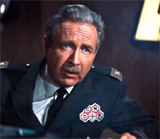
Col. Donald Reid (Arthur O'Connell)
|
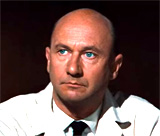
Dr. Michaels (Donald Pleasence)
|
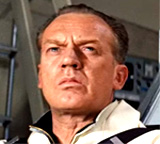
Dr. Peter Duval (Arthur Kennedy)
|
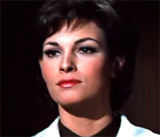
Cora Peterson (Raquel Welch)
|
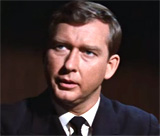
Captain Bill Owens (William Redfield)
|
- a large anatomical
map was projected, as Dr. Duval identified the location of Dr. Benes'
deadly blood clot; he explained how it would be "impossible
to get at without damage to the intervening tissue which would
prove fatal to Benes"; the only way to reach the blood clot
would be through the arterial system (via the carotid artery); the
surgical crew-team would be placed inside a high-tech,
bubble-domed, nuclear-powered submarine, the USS Proteus;
they (and the sub) would be reduced to "about the size of
a microbe," and would then be injected into the arterial bloodstream
of Benes' body; they would travel through the patient's arteries
(in red) to the brain to dissolve the clot with a laser beam to
relieve pressure on his brain; meanwhile,
Benes would be placed in "deep hypothermia" to freeze
him and slow down his bodily processes
- Dr. Michaels interjected that the only area of danger
from turbulence inside a blood vessel was within the heart; after
reaching the blood clot, Dr. Duval would dissolve
the blood clot with a laser beam, and then the team would return by
way of the venous system (in blue) - reaching the base of the neck
to be removed with a hypodermic needle
- the entire mission would be monitored in the main
operations room; a giant life-sized model
of the interior circulatory system of the comatose patient would
be viewed to monitor and precisely pinpoint the location of the
submarine's 'fantastic voyage'; the nuclear-powered
submarine's location was communicated wirelessly to observers in
the military complex, and also monitored and tracked by navigator
and circulatory specialist Dr. Michaels; the crew could be extracted
by medical surgeons if an emergency developed; they needed to be
wary of natural defensive attacks by white blood corpuscles or antibodies
- the team was led into the Sterilization Room and
then to the Miniaturization Room, where the sleek submarine craft
(fitted on top with a transparent plastic bubble dome) was positioned
on a supportive cradle above a honeycomb-patterned Zero Module;
in a small lead box, a minuscule particle of radioactive material
would be used to atomically-power or fuel the sub after it was
reduced in size; the crew was strapped into the sub before it was
miniaturized
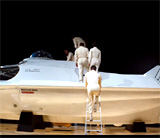
Entering the Sub - The USS Proteus
|
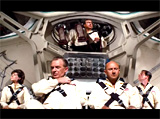
Five Crew Members Awaiting Miniaturization
|
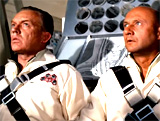
Fears During the Miniaturization Process
|
- a POV shot from inside the vessel looked out to
illustrate its shrinkage; the microscopic sub was then carefully
placed and submerged into a gigantic hypodermic needle filled with
a saline solution; Dr. Michaels suffered an attack of claustrophobia
and cried out: "I
can't breathe. I've got to get out"; a few moments later,
he recovered and explained that he had been buried alive for two
days during an air raid in England
- in Phase 3, the hypodermic needle was also miniaturized;
a count-down began from 60 minutes now that they were fully reduced
in size; in Phase 4, the vessel - amidst the turbulent fluid and
similar to a roller-coaster ride - was injected via the hypodermic
needle into the arterial bloodstream (via the carotid artery) of
the patient through a targeted spot on his neck - seen from various
perspectives; the sub entered the body and was now surrounded by
globular red blood cells (looking like multiple lava-lamps)

|
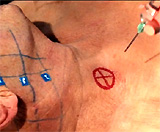
|
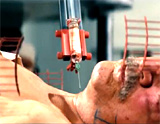
|
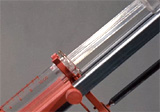
The Actual Injection
|
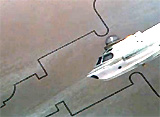
Tracking The Sub During the Injection
|

The Injection-Ride Into the Bloodstream
|
|
The Miniaturized USS Proteus Injected
Into Benes' Bloodstream
|
- as they beheld the colorful sights of the bloodstream
(viewing corpuscles carrying oxygen) in front of them in an "ocean
of life," Dr. Duval philosophically speculated: "The
medieval philosophers were right: Man is the center of the universe.
We stand in the middle of Infinity, between outer and inner space,
and there's no limit to either"
- due to strong
currents, a whirlpool, and a rare artery-vein connection, the sub
was set off-course into the jugular vein instead of the carotid
artery; they realized they had been detoured by the changed color
of the cells surrounding the sub - now blue instead of red; they
determined that there had been a "forced joining of a vein
and an artery" (an arteriovenous fistula) that probably occurred when the patient
was injured; they realized that they were now headed on a course
toward the superior vena cava (SVC) in the direction of the heart,
where they would be crushed by thumping heartbeats; 9 minutes had
passed since miniaturization
- in order to survive the turbulence of the heart
(and prevent the utter destruction of the Proteus), they needed
to induce cardiac arrest momentarily, for no more than 60 seconds,
to allow the submarine to detour through it - but it risked killing
the comatose patient; according to slide-rule
calculations by Gen. Carter, at top speed, it would take the Proteus crew
57 seconds to navigate the route; during the passage, it was noted
that the sounds of the heart were like a barrage of heavy
artillery; Dr. Michaels described how the heart was a marvelous
organ, capable of "four million beats" in a lifetime;
Dr. Duval marveled gloomily: "And every beat separates
a man from eternity"; the maneuver was successful - the crew
progressed into the right atrium and out through the pulmonary semilunar
valve into the pulmonary artery in 57 seconds, in time to revive Benes' heart
- on the way to the left lung, they entered a narrow capillary and had
a close-up view of the oxygenation process (corpuscles turning
from blue to bright red); Cora marveled: "We're the first
ones to actually see it happen" - and Dr. Duval was in awe: "The
living process" and labeled the process as one of the "miracles
of the universe" - evidence of a Divine Creator and Intelligence ("the engineering of
the cycle of a breath"); during a brief
philosophical debate between intelligent design vs. evolution, Dr.
Michaels downplayed the process as only an evolved or rational phenomenon: "I
wouldn't call it a miracle. Just an interchange of gases - the end
product of five hundred million years of evolution"
- the two were interrupted by a
warning buzzer-alarm; the ship's pilot-commander Bill Owens notified
the crew that the Proteus was losing air pressure in its
floatation tanks; Grant found that the left-side tank
had lost pressure and had mysteriously failed; it was possibly
attributable to a short in the electrical valve circuit system;
their progress would be impeded for the remainder of the mission
- Grant proposed that everyone on the team, except
for Owens, exit the sub (wearing scuba-diving gear) and replenish
the sub's oxygen supply; they would use a snorkel tube attached
to the patient's lungs to extract and force oxygen into the sub's tanks
- while preparing for the trip outside the sub, at
about 42 minutes of remaining time, Cora simultaneously discovered
that the surgical laser rifle that was to be used to perform the
blood-clot procedure was damaged - it was not strapped down to
its mounting and had become dislodged; Dr. Duval suspiciously suggested
it must have come loose during turbulence - evidence of a enemy
saboteur in the group that had tampered with it
- during the repair mission of increasing
the sub's air pressure, Dr. Michaels noted "rocks" or impurities
embedded in the lung, due to carbon from smoke and specks of dust;
after successfully completing the mission, Grant's safety tether
line attached to the sub snapped (was it sabotage?), and he was
sucked into the lungs and buffeted around; he was able to get back
into the blood stream with the other crew and return to the ship;
they then proceeded through the pleural cavity
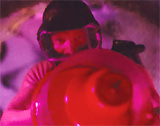
Grant With the Snorkel Tube To Replenish Air in
the Sub's Tanks
|

Gauge Showing Increased Air Pressure
|
- upon their return, Cora - during a closer examination
- discovered that the laser gun had a broken trigger wire; Dr.
Duval also found a smashed transistor - meaning they had no way
to "fire" the laser's lamp; the solution was to repair
the laser by cannibalizing parts (one transistor and a circuit
wire) from Grant's wireless radio
- leaving the lung's pleural sac, the Proteus then
entered the lymphatic system (and one of its lymph nodes), functioning
in the body to drain off excessive fluid from the tissues; there,
Grant and Dr. Michaels noticed that seaweed-like
reticular fibers and antibodies appeared to ominously multiply;
the reticular fibers could easily clog the sub's vents and water-jet
intakes, causing overheating; Dr. Michaels warned: "Antibodies
destroying bacteria or any other foreign invader that threatens
the system"
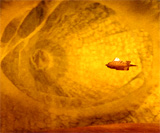
Entering the Lymphatic System
|
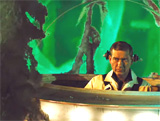
In the Sub's Dome, Capt. Owens Viewing Seaweed-Like
Fibers Within the Dome
|
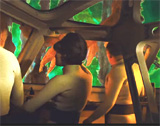
Passage Blocked and Slowed by Reticular Fibers in the Lymphatic
System
|
- due to the slow progress of the sub, Dr. Duval proposed
that the best way to now proceed was to change course and pass through
Dr. Benes' left inner ear and then go by way of the endolymphatic
duct; during the more hazardous passage, another 'scuba-diving'
trip was required to clear and remove the fibrous material in order
to halt the sub's overheating (resulting in a lack of propulsion)
- back in the control room, Gen. Carter reached for
another cup of coffee and noticed an ant crawling around on spilt
sugar specks; he resisted the temptation to squash the insect with
his thumb, and Col. Reid remarked: "You'll wind up a Hindu.
They respect all forms of life, however small"
- at about the 21 minute mark, during the successful vent-clearing mission
outside the sub performed by Grant, Cora and Dr. Michaels, a destructive
shock wave of vibrations was produced when one of the nurses in
the operating room accidentally dropped a pair of surgical scissors
- and the ship and all of its crew were violently jostled; in a
memorable sequence, Cora was thrown about and into some
cilia fibers due to the shock waves - causing damage and prompting
antibodies to attack her body after regarding it as a foreign object; the
skittish Dr. Michaels warned: "If the antibodies reach her,
they'll attack as if she were bacteria"
- as she was brought back to the ship and through the reflooded airlock
and into the ship, the antibodies continued to attack, and she screamed:
("They're tightening up - Please, I can't breathe");
the crew rescued her by groping her chest
and throat and pulling the seaweed-like antibodies from her body
as they crystallized
|
The Attack of White Blood Cells - and The Rescue
of Cora
|
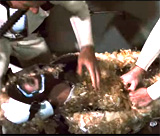
|
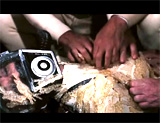
|

|
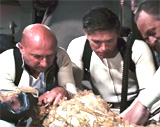
|
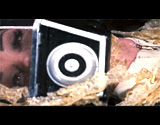
|
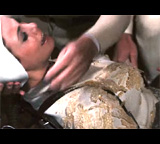
|
- with only 12 minutes remaining, from the middle
ear, the sub passed through the endolymphatic duct and back into
the vascular system before it entered into the brain and the location
of the clot; as they entered the base of the brain, Dr. Duval again
went into a reverie: "Yet all the suns that light the corridors of the universe shine dim,
before the blazing of a single thought…" - and his
thought was completed by Grant: "proclaiming in incandescent
glory the myriad mind of man"; Dr. Michaels was more sarcastic:
"Let me know when we pass the soul"; Duval answered him: "The
finite mind cannot comprehend infinity, and the soul which comes
from God is infinite"; they came upon a "dark spot" - recognized
by Dr. Duval as the site of the injury that needed to be healed
- the crew determined that it had only a total of
six minutes to complete their mission before de-miniaturization
began (four minutes to perform the blood clot operation with the
laser and two minutes to get to the removal point); the crew was
under tremendous pressure outside the ship to succeed
- once the operation to relieve the pressure was completed
in about four minutes by Dr. Duval (with Cora and Grant), the mission
was meanwhile being sabotaged by twitchy on-board crew member Dr.
Michaels who wanted to abort the mission; he knocked out pilot
Owens with a blow to the head, took control of the sub, and attempted
to crash it at full speed into the clot area of fragile brain cells
(the central nerve) to kill the patient
- the remaining crew members were saved by heroic
Commander Grant, who grabbed Duval's laser and shot at the high-tech
sub to incapacitate it; after it was diverted and crashed into
some dendrite tissue, puffy, jelly-fish like white corpuscles converged
to envelope, consume, and digest both the submarine and Dr. Michaels
who was physically pinned and trapped inside the bubble-dome
- before the Proteus was entirely injested,
Grant returned to the Proteus to rescue Owens, and he watched as
the saboteur Dr. Michaels was engulfed and suffocated by a gigantic
white corpuscle (macrophage)
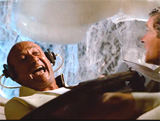
|
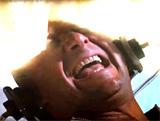
|
|
Dr. Michaels' Death Sequence - Consumed
by White Corpuscles
|
- the four surviving crew hurriedly swam along the
optic nerve and were able to emerge safely from the tear duct at
the corner of the patient's right eye to be rescued - they were
viewed in a magnifier and lifted out of the teardrop on a microscope
slide by Col. Reid, and placed on the Zero Module in the Miniaturization
Room just before they reverted back to normal size
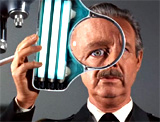
|
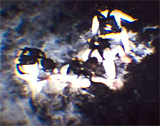
|
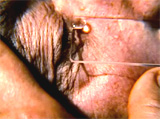
|
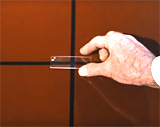
|
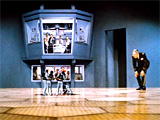
|
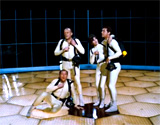
|
|
Extraction: Crew Ejected from Patient's Tear
Duct in Eye, Before De-Miniaturizing on the Zero Module
|
- [Note: One of the scientific flaws or plot holes
of the film was the fact that the Proteus remained in Benes'
body, as well as Dr. Michaels' digested corpse, the laser gun and
hundreds of gallons of saline solution in the huge hypodermic cylinder
used during the initial injection; at the end of the 60 minutes,
there would have been enough left-over elements that had the potential
to expand, and ultimately would have exploded and killed the patient.]
|
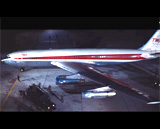
TWA Jet Flight Landed at LAX, With Czech Defector on Board
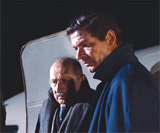
(l to r): Dr. Benes (Jean Del Val) with Gov't Agent Charles Grant (Stephen
Boyd)
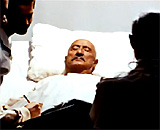
The Patient - Dr. Benes
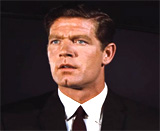
Heroic Gov't Agent Charles Grant (Stephen Boyd)

The CMDF Logo

Dr. Michaels (Donald Pleasence) Pointing Out Artery (Red) Pathways on Projected
Model Image
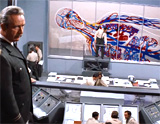
The Observation Room and Control Center
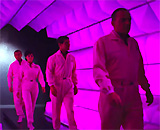
The Sterilization Room

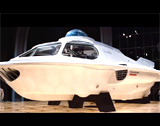
The Full-Sized USS Proteus
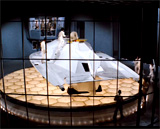

Delicately Picking Up the Shrunken Submarine From the Zero Module
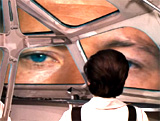
Giant-Looking Technician Looking Inside the Miniscule
Sub From the Outside

USS Proteus Submerged into Saline Solution Within Hypodermic Needle
Before Injection
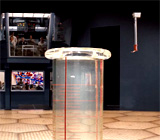
The Tiny Sub Dropped Inside a Giant-Sized Hypodermic Needle

The Sub Entering the Body
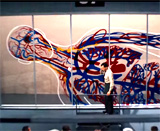
Monitoring and Tracking Location of Sub Within
the Life-Sized Model
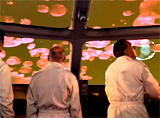
Viewing From the Sub After It Was Injected Into the Bloodstream
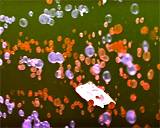
Red Blood Corpuscles in an Artery
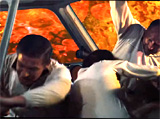
A Whirlpool Sending Them Off-Course
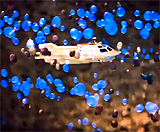
Off-Course - Now Viewing Blue Corpuscles in a Vein
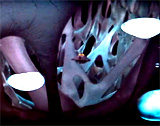
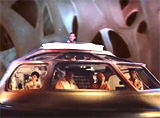
The Proteus Detouring Into and Through the Stopped Heart (Under Artificial
Cardiac Arrest)
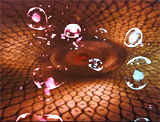
A Visualization of the Oxygenation Process
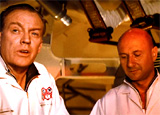
The Brief Debate Between Dr. Duval and Dr. Michaels About the "Miracle"
of Oxygenation
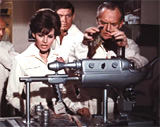
Cora's Discovery of Surgical Laser Dislodged and Damaged
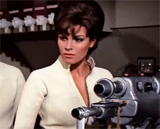
And Cora's Later Discovery of the Sabotaged Laser Gun - Broken Trigger
Wire
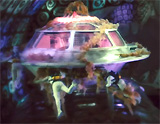
Clearing 'Sea-weed' Like Antibodies from Sub's Vents After Passing Through the
Lymphatic System

Clanging Noise From Dropped Scissors Caused Massive Shock
Wave in Inner Ear
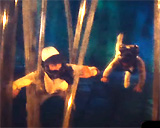
Cora Jostled Into Cilia Fibers and Damaging Them - Requiring Her Rescue
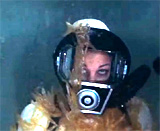
Antibodies Attacking Cora's Body in the Sub's Airlock
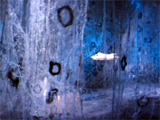
At the Base of the Human Brain
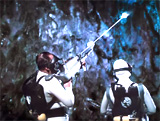
Dr. Duval Repairing the Brain's Blood Clot With Laser
Beam

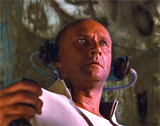
Dr. Michaels' Attempt to Sabotage the Mission by Crashing
the Sub
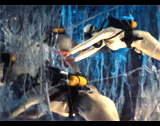
The Four Remaining Crew Members Swimming Along the Optic Nerve to The Corner
of the Eye to be Rescued Before Enlarging
|





































